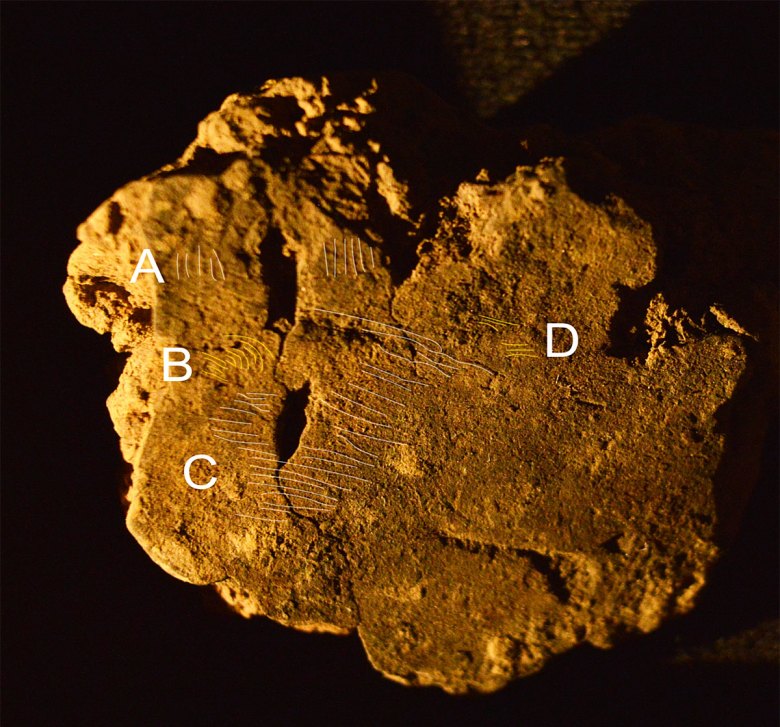A 5,000-Year-Old Fingerprint on Ancient Pottery Reveals a Glimpse into Neolithic Life

In a fascinating discovery, researchers have uncovered a 5,000-year-old fingerprint on a pottery shard in Scotland’s Orkney archipelago. This remarkable find provides a rare and personal connection to the Neolithic people who once inhabited the area, offering insights into their daily lives and craftsmanship. The fingerprint, preserved on a piece of ancient pottery, allows us to peer into a moment frozen in time, revealing the human touch behind the creation of this ancient artifact.
The Discovery of a Lifetime

Around 3000 B.C., a potter in what is now Scotland’s Orkney archipelago left an indelible mark on a clay vessel. This fingerprint, left on the surface of a clay vessel, was recently discovered on a pottery shard at the Ness of Brodgar, an archaeological site known for its significant Neolithic structures. The Ness of Brodgar is a site of immense historical importance, housing a vast complex of Neolithic buildings and offering a wealth of artifacts that continue to reveal the secrets of ancient life.
Uncovering the Fingerprint
The fingerprint was first noticed by ceramics specialist Roy Towers, who identified the mark while examining a clay shard from the site. To confirm the finding, researchers employed Reflectance Transformation Imaging (RTI), a technique that combines photographs taken under different lighting conditions to create a highly detailed virtual model. This method confirmed that the mark was indeed a fingerprint, preserved for millennia on the ancient pottery.
A Connection to the People Behind the Pottery

The discovery of this fingerprint offers a unique and personal connection to the Neolithic people who once lived in Orkney. Excavation director Nick Card emphasized the importance of this find, stating that it brings the ancient potters into sharper focus, reminding us that behind every artifact lies a human story. The fingerprint serves as a tangible link to the individuals who created the pottery, providing a glimpse into their lives and the cultural context in which they worked.
The Significance of the Ness of Brodgar
The Ness of Brodgar is part of the Heart of Neolithic Orkney, a UNESCO World Heritage site designated in 1999. This site includes several significant Neolithic monuments, such as the Stones of Stenness, the Ring of Brodgar, and Maeshowe, as well as the remains of ancient settlements. The pottery shard with the fingerprint is just one of many artifacts uncovered at the site, which has yielded the largest collection of late Neolithic Grooved Ware pottery in the U.K.
The Legacy of Neolithic Pottery

The Grooved Ware pottery found at the Ness of Brodgar includes a variety of vessels, such as drinking cups, buckets, and basins, often decorated with geometric patterns. These artifacts provide valuable insights into the artistic and cultural practices of the Neolithic people. According to Roy Towers, the pottery reflects the talents and sophisticated minds of the artisans, offering a key to understanding their thoughts and way of life.
The Cultural Development of Orkney
The Ness of Brodgar site was part of a broader period of cultural development in Orkney, which began around 4000 B.C. This era saw the arrival of farmers from northwestern and northern France, who brought with them new agricultural practices and art forms. Between 3300 and 2800 B.C., the inhabitants of Orkney developed a thriving cattle farming culture, built monumental structures, and created the distinctive Grooved Ware pottery that is so closely associated with the region.
Future Research and Analysis

While ancient fingerprints are not uncommon at archaeological sites, the discovery of this particular fingerprint offers a poignant reminder of the personal connections we can forge with the past. Researchers hope to further analyze the fingerprint to determine the gender and age of the potter, providing even more detailed insights into the lives of the people who once inhabited Neolithic Orkney.
Conclusion
The discovery of a 5,000-year-old fingerprint on a pottery shard in Scotland’s Orkney archipelago serves as a powerful reminder of the enduring human connection to the past. This small yet significant find allows us to connect with the individuals who shaped the Neolithic world, offering a tangible link to their lives and craftsmanship. As researchers continue to study the Ness of Brodgar and its many artifacts, we can expect to learn even more about the people who left their mark—both literally and figuratively—on this ancient landscape.
Video
News
The Hanging Temple: China’s 1,500-Year-Old Cliffside Marvel of Faith and Engineering
The Hanging Temple: China’s 1,500-Year-Old Cliffside Marvel of Faith and Engineering Perched precariously on the cliffs of Mount Heng in Shanxi Province, China, the Hanging Temple, also known as Xuankong Temple, Hengshan Hanging Temple, or Hanging Monastery, is an architectural…
The Willendorf Venus: A 30,000-Year-Old Masterpiece Reveals Astonishing Secrets
The Willendorf Venus: A 30,000-Year-Old Masterpiece Reveals Astonishing Secrets The “Willendorf Venus” stands as one of the most revered archaeological treasures from the Upper Paleolithic era. Discovered in 1908 by scientist Johann Veran near Willendorf, Austria, this small yet profound…
Unveiling the Maya: Hallucinogens and Rituals Beneath the Yucatán Ball Courts
Unveiling the Maya: Hallucinogens and Rituals Beneath the Yucatán Ball Courts New archaeological research has uncovered intriguing insights into the ritual practices of the ancient Maya civilization. The focus of this study is a ceremonial offering found beneath the sediment…
Uncovering the Oldest Agricultural Machine: The Threshing Sledge’s Neolithic Origins
Uncovering the Oldest Agricultural Machine: The Threshing Sledge’s Neolithic Origins The history of agricultural innovation is a fascinating journey that spans thousands of years, and one of the earliest known agricultural machines is the threshing sledge. Recently, a groundbreaking study…
Nara’s Ancient Sword: A 1,600-Year-Old Protector Against Evil Spirits
Nara’s Ancient Sword: A 1,600-Year-Old Protector Against Evil Spirits In a remarkable discovery that has captured the attention of archaeologists and historians alike, a 7.5-foot-long iron sword was unearthed from a 1,600-year-old burial mound in Nara, Japan. This oversized weapon,…
The Inflatable Plane, Dropped Behind the Lines for Downed Pilots
Experimental The Inflatable Plane, Dropped Behind the Lines for Downed Pilots The Inflatoplane from Goodyear was an unconventional aircraft developed by the Goodyear Aircraft Company, a branch of the renowned Goodyear Tire and Rubber Company, also famed for the Goodyear…
End of content
No more pages to load











